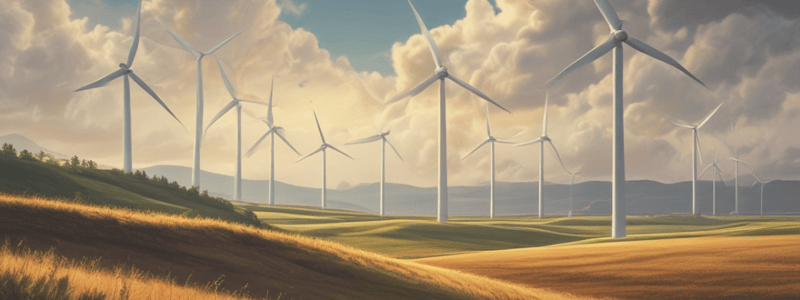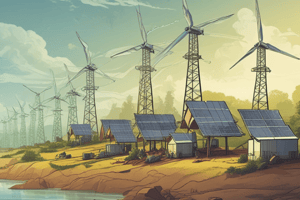Podcast
Questions and Answers
What is the main source of air pollution and greenhouse gases?
What is the main source of air pollution and greenhouse gases?
- Wind energy
- Hydroelectric energy
- Fossil fuels (correct)
- Solar energy
What is the purpose of a wind turbine?
What is the purpose of a wind turbine?
- To saw wood
- To pump water
- To grind grain
- To generate electricity (correct)
What creates the wind?
What creates the wind?
- The unequal heating of the Earth's surface by the sun (correct)
- The Earth's rotation
- The movement of oceans
- The Earth's gravity
What is the significance of wind energy?
What is the significance of wind energy?
When were wind turbines that could generate electricity first invented?
When were wind turbines that could generate electricity first invented?
What type of energy does the wind turbine transform the kinetic energy of wind into?
What type of energy does the wind turbine transform the kinetic energy of wind into?
What is the minimum wind speed required for larger scale turbines to generate electricity?
What is the minimum wind speed required for larger scale turbines to generate electricity?
Why are off-shore wind farms becoming more popular?
Why are off-shore wind farms becoming more popular?
What is a major limitation of wind energy?
What is a major limitation of wind energy?
What is a potential environmental concern with wind turbines?
What is a potential environmental concern with wind turbines?
Flashcards are hidden until you start studying
Study Notes
Electricity and Energy Sources
- The majority of electricity worldwide comes from burning non-renewable fossil fuels, such as coal, oil, and natural gas.
- Fossil fuels are a cheap and readily available source of energy, but they also cause air pollution and greenhouse gases, contributing to global climate change.
Wind Energy
- Wind energy is a clean, renewable energy source that does not produce greenhouse gases or pollution.
- Wind turbines can supply energy to homes, businesses, and entire communities.
- Wind energy holds promise as a significant source of electricity for the future.
Harnessing the Wind
- Wind is created by the sun heating the Earth's surface unevenly, resulting in areas of high and low pressure.
- Wind turbines transform the kinetic energy of wind into mechanical energy, then into electrical energy.
How Wind Turbines Work
- Wind blows across the blades of the turbine, causing them to turn.
- The spinning motion is converted into mechanical energy, then into electrical energy through a generator.
- The electrical energy is transferred to power lines as electricity.
Wind Turbine Design
- Wind speed for larger turbines needs to be about 7-9 miles per hour, while smaller turbines need less.
- The wind needs to be consistent and sustained, and turbines need to be tall enough to catch wind that has not been interrupted by obstacles.
Wind Farms
- Wind farms are collections of many wind turbines located in one area.
- They can produce a significant amount of electricity, with hundreds to thousands of turbines in one wind farm.
- Wind farms must be located in areas with consistent, predictable winds.
Off-Shore Wind Farms
- Off-shore wind farms are located in the ocean, where winds are more consistent, predictable, and stronger.
- They can produce more energy than on-shore wind farms, but are often more expensive to build.
Pros of Wind Energy
- Wind energy is a clean, renewable energy source.
- No greenhouse gases or pollution are produced during operation.
- Land surrounding turbines can still be used for farming.
- Low operating costs once turbines are installed.
- Many jobs are created in manufacturing, installing, and maintaining wind turbines.
Cons of Wind Energy
- Wind can be inconsistent and unpredictable, leading to inconsistent energy production.
- Geographic areas suitable for wind farms are limited and often in rural areas.
- Wind energy systems are expensive to make and install.
- Some people find wind turbines noisy and unattractive.
- Birds and bats can be killed by turbine blades.
Wind Turbine Pros and Cons
- Wind turbines produce renewable, clean energy.
- They require very little ground space.
- They create many job opportunities.
- They are cost-effective once operational.
- They can be noisy and unattractive.
- They can harm birds and bats.
Wind Farm Pros and Cons
- Wind farms can produce a great deal of clean, renewable energy.
- They reduce dependence on non-renewable fossil fuels.
- They provide income to farmers leasing land for turbines.
- They provide numerous job opportunities.
- They can be noisy and visually unappealing.
- Some people do not want wind farms located nearby.
Studying That Suits You
Use AI to generate personalized quizzes and flashcards to suit your learning preferences.




